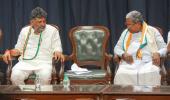A rotating chief ministership as a way to appease factions can work only if there is a credible guarantor, explains Aditi Phadnis.

As the curtain came down on the leadership struggle in the Congress in Karnataka, culminating in Siddaramaiah becoming chief minister, there is still no clarity about whether he and his closest rival, D K Shivakumar, have actually agreed on a rotational deal over chief ministership.
Exactly why this 'arrangement' is being kept such a closely guarded secret is a mystery.
It is a perfectly normal power-sharing formula followed all over the world: In Israel, Malaysia, and even the fount of democracy, Britain, where in 1994, the unexpected death of John Smith, then leader of the Labour Party, led to a meeting between the two acknowledged bosses of the party: Tony Blair and Gordon Brown.
The two men agreed (it is thought, over dinner at a restaurant called Granita in London's Islington, which is why the pact came to be known as the Granita Agreement) that Mr Brown would not stand in the Labour leadership elections to afford Mr Blair an easier victory.
In return, Mr Blair would appoint him chancellor of the exchequer with extensive powers over domestic policy.
Reportedly, Mr Blair agreed, if he became prime minister, to stay on for only two terms and then quit in Mr Brown's favour.
He didn't and the two men later fought bitterly after -- per Mr Brown -- Mr Blair failed to keep his end of the bargain.
In India, given the nature of the two main parties, the Bharatiya Janata Party and the Congress, it is a surprise it took so long for this kind of arrangement to gain currency.
It was tried out for the first time in Jammu and Kashmir in 2002, and the main negotiator was Congress leader Manmohan Singh, although Ghulam Nabi Azad says it was he who thought of a rotational arrangement, out of the nobility of his heart.
In his autobiography, Mr Azad writes that the Congress offered the formula to Mufti Mohammad Sayeed that the post of chief minister could be held by the two parties by rotation.
However, the Mufti was adamant that as his party, the People's Democratic Party, won more seats in the Kashmir Valley, he should be given chief ministership for the first three years, throwing a hissy fit when Sonia Gandhi asserted that as the Congress had the bigger number (42 MLAs), Mr Azad should take the first term.
'That is how Mufti, whose party had come third in the elections, with just 16 MLAs, became the CM, while I, despite having the support of 42 MLAs, had to return to national politics,' Mr Azad writes.
The Mufti turned out to be more of a gentleman than many others. At least he let Mr Azad have his turn.
That was not the case in Karnataka in 2006, when Janata Dal-Secular leader H D Kumaraswamy, who engineered a coup of sorts to form a coalition government with the BJP, with 45 legislators as against the BJP's 79, forged a gentleman's agreement to share power for 20 months each before the assembly polls, which were supposed to be held in 2009, but reneged on his part of the deal.
B S Yediyurappa became chief minister, but for seven days, as Mr Kumaraswamy withdrew support from the coalition, forcing the government to fall.
More recently, after the 2018 Chhattisgarh elections, as part of Rahul Gandhi's plan to introduce new Congress faces in the state, Tamradhwaj Sahu was chosen to become chief minister.
Of the 90 assembly seats, the Congress had won 68, trouncing the BJP, which got 15.
The leader of the Opposition in the outgoing assembly was Tribhuvaneshwar Saran Singh Deo.
He expected a big role in the new government, maybe even the top job.
But Bhupesh Baghel had the support of the MLAs as well.
Mr Baghel and Mr Singh Deo had just returned from New Delhi, where they had each been given some sort of assurance of getting the top job.
But when they landed in Raipur they found Mr Sahu's supporters setting off the fireworks.
To edge Mr Sahu out, they agreed to Ahmad Patel's formula of half and half.
But then, Covid claimed Patel and Mr Baghel developed amnesia about the arrangement.
Now you had only Mr Singh Deo's word that he was given an assurance he would be CM for the second half of the term. And Mr Baghel is still in the saddle.
And, of course, the Ashok Gehlot-Sachin Pilot saga in Rajasthan is a work in progress.
The fact is, just as at the Centre, where the prime minister is everything, and, no matter what you might say, the deputy prime minister's position has no real additional powers, so also in the states, the deputy chief minister counts for nothing unless he has 'meaty' portfolios.
At the Centre, L K Advani, who felt emasculated by the power Brajesh Mishra, national security advisor and principal secretary to the PM, wielded over then prime minister Atal Bihari Vajpayee, egged on Jaswant Singh and George Fernandes to petition Vajpayee to make him (Advani) deputy PM.
This made no material difference to anyone, least of all officialdom.
So, the conclusion we have to reach is: A rotating chief ministership as a way to appease factions can work only if there is a credible guarantor.
And deputy chief ministership, which Mr Shivakumar has got, is just that: A deputy.











